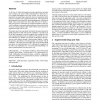Free Online Productivity Tools
i2Speak
i2Symbol
i2OCR
iTex2Img
iWeb2Print
iWeb2Shot
i2Type
iPdf2Split
iPdf2Merge
i2Bopomofo
i2Arabic
i2Style
i2Image
i2PDF
iLatex2Rtf
Sci2ools
VR
2008
IEEE
2008
IEEE
The Effects of Virtual Reality, Augmented Reality, and Motion Parallax on Egocentric Depth Perception
As the use of virtual and augmented reality applications becomes more common, the need to fully understand how observers perceive spatial relationships grows more critical. One of the key requirements in engineering a practical virtual or augmented reality system is accurately conveying depth and layout. This requirement has frequently been assessed by measuring judgments of egocentric depth. These assessments have shown that observers in virtual reality (VR) perceive virtual space as compressed relative to the realworld, resulting in systematic underestimations of egocentric depth. Previous work has indicated that similar effects may be present in augmented reality (AR) as well. This paper reports an experiment that directly measured egocentric depth perception in both VR and AR conditions; it is believed to be the first experiment to directly compare these conditions in the same experimental framework. In addition to VR and AR, two control conditions were studied: viewing real-worl...
| Added | 01 Jun 2010 |
| Updated | 01 Jun 2010 |
| Type | Conference |
| Year | 2008 |
| Where | VR |
| Authors | Adam Jones, J. Edward Swan II, Gurjot Singh, Eric Kolstad |
Comments (0)

